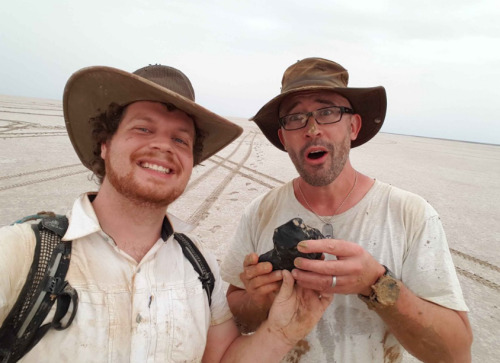#fireballs
Chasing shooting stars
It’s New Year’s Eve, and after a tense three days of searching in the heart of the South Australian outback, Professor Phil Bland has finally found the impact site. After leaping off his quad bike and running across the salty mud flats, he falls to his knees and thrusts his hand straight into a hole smashed into the landscape. His arm disappears nearly half a metre into the earth - and when it emerges again, there’s a mud-slathered rock clutched in his fist.
“It’s an iron meteorite, mate!” are Bland’s first, breathless words. He holds it reverently, wiping off the thick, clay-like mud. He’s kneeling on Kati-Thanda, also known as Lake Eyre, and what he holds in his hands is a hunk of rock older than the Earth itself.

It’s also the first proof that the Desert Fireball Network works.
Built by Professor Bland’s research team at Curtin University, WA, the Desert Fireball Network is an automated meteor tracking system made up 49 digital cameras dotted across the Australian outback. Over the next few years, it’s projected to watch a third of Australian skies - and it does exactly what its name says. It looks for fireballs.
Asmeteors from the wider solar system plough down into the Earth’s atmosphere at hypersonic velocities, they burn up. For fleeting moments, they sear across the sky and light up the darkness. Often, bits of these meteors hurtle all the way down to the surface. The multiple cameras of the Fireball Network can spot a fireball and triangulate its path through the atmosphere, so its trajectory can be reconstructed in 3D. This can give information about the meteorite’s mass, its orbit and origins in the Solar System, and the location where it smashed into the surface.

On November 27th last year, Professor Bland’s team got the heads up from their network that a fireball had blazed through the atmosphere and fallen to Earth in the middle of South Australia. Its landing site was narrowed down to within a small area in the bed of Lake Eyre, a massive salt lake, and so they knew they had to get to it fast: if too much rain came, any trace of the impact could be washed away. They organised to fly a spotter plane over the area to get eyes on the impact site, then the team flew across states, rented 4WDs and camping gear, got permission from the Arabana people, who are the traditional custodians of Kati-Thanda… Then finally, on December 31st, Bland pulled the meteorite from the mud just hours before heavy rains swept across Lake Eyre.
It turns out that the meteorite itself is fairly ordinary - if you can call any 4.6 billion year old object ordinary - but the most interesting thing is that the Fireball Network could attach an orbit to it. It was traced it back to the asteroid belt between Mars and Jupiter, where it used to be part of a larger asteroid that broke up in an impact. This gives it incredibly useful context that other meteorite discoveries don’t have.
If the team can observe and study enough meteorites and their original orbits, they’ll be able to make a geological map of the solar system. This will give invaluable insights into the solar system’s formation, especially the formation of the planets. Hopefully, it will help answer questions like: how did the Earth form? How are planets made?
If you want to keep updated on the project, you can download their app - which also lets you contribute by reporting fireball sightings of your own, from anywhere in the world!
All images courtesy of Fireballs in the Sky
Post link




